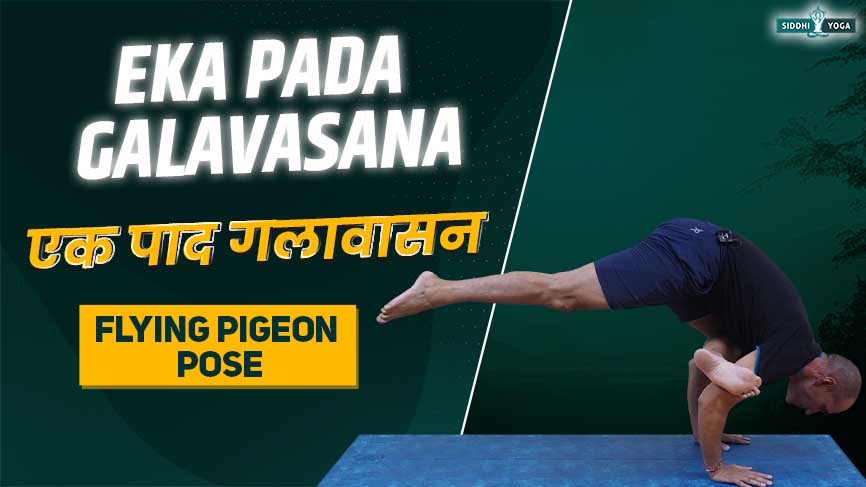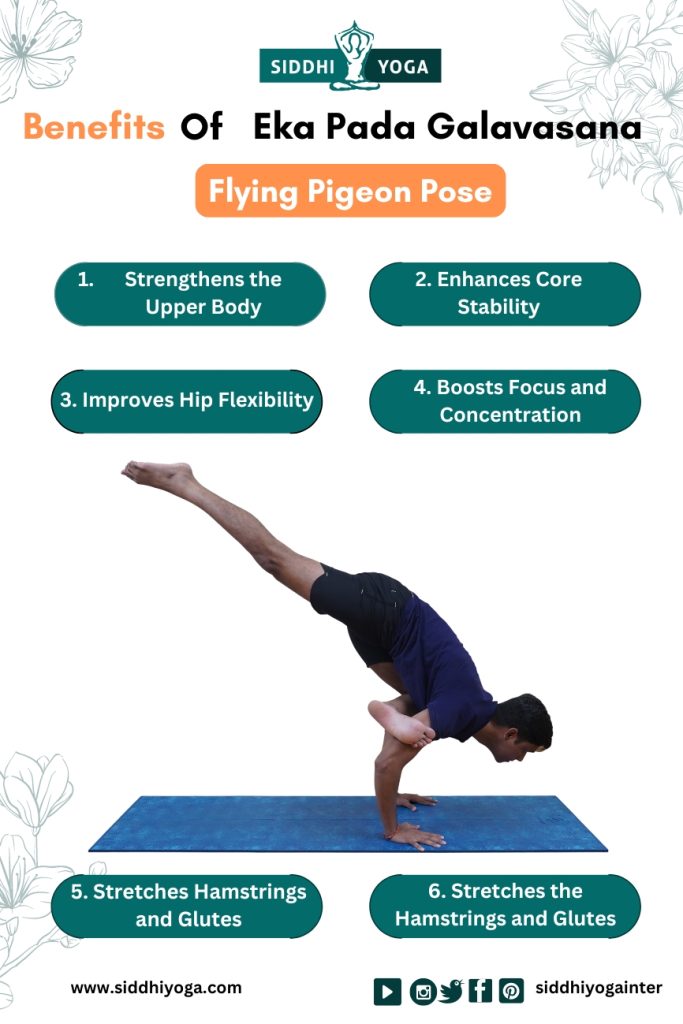
Pada: Foot
Galava: Name of the ancient sage
Asana: Pose
Eka Pada Galavasana at a Glance
Eka Pada Galavasana which is also known as the flying pigeon pose, is part of Ashtanga yoga and is a challenging arm balance that is practiced in Hatha yoga. This is a variation of the Half pigeon pose and an advanced variation of the pigeon pose. This is named after the sage ‘Galava’. The son of Vishwamitra (famous Rishi).
Benefits:
- It helps to strengthen your arms, shoulders, legs and back.
- It helps to strengthen your abdominal organs and tones the groin area.
- It helps to build your inner strength and enhances your body posture.
- This also enhances the strength of your abdominal muscles.
- This also improves your balance and confidence.
Who can do it?
Eka Pada Galavasana is a challenging, pose so people with intermediate, and advanced level yoga practitioners can do this yoga posture. People with good levels of arm and core strength can do this pose. Sportspersons and dancers can do the Eka Pada Galavasana yoga pose. People with both physical and mental strength can do this pose.
Who should not do it?
Beginners should avoid doing the Eka Pada Galavasana pose. People struggling with balance and strength issues should avoid it. Any injury to your arms, wrists, shoulder, back, legs, or ankle should avoid doing this pose. Pregnant women should avoid it. Women during their menstrual cycle should avoid doing it. If you have undergone any surgery avoid doing this pose.
How to Do Eka Pada Galavasana?
Follow the Step-by-Step Procedure
- This is an advanced and challenging pose, wherein you need, arm strength, and good willpower to support your physical and mental strength to get into the final posture. Do the flying pigeon prep pose.
- You can just start by coming to the Mountain pose, standing straight, your legs firm with hip-width distance.
- Now inhale and slightly lower your pelvis, knees bent, and keep your feet firm on the ground.
- Keep breathing and taking the help of the right hand, lift your right foot (crossing your right ankle) over your left thigh, and place it on eh left thigh (half chair position). Be in this position and maintain the balance for a few breaths.
- Slowly exhale and bring your palms down to the floor, (palms shoulder-width distance) place it on the floor and slowly shift your weight forward a bit, keeping your body in balance.
- Bend and squeeze your elbows bring your right leg shin near your upper left arm and try to hook your right foot, around your left upper arm.
- In this position, you come onto the ball of your left foot (back leg) move your chest forward a bit inhale squeeze your left heel, and bring it toward your buttocks, pressing your palms against the floor.
- Let your fingers be wide and firm to get a deeper forward bend (torso forward) and exhale slowly straighten your leg and point your foot straight and your right foot is tucked or rests on the right upper arm.
- Be in this pose, within your comfort limit, and when you are ready to release the pose, bring your left leg (left knee) to the floor and your right leg to the floor and come back to the Tadasana pose.
- Relax for a few breaths and then do it by bringing your left foot on your right thigh.
What are the Benefits of Eka Pada Galavasana?

- The Eka Pada Galavasana pose helps to enhance the strength of your arms, wrists, and shoulders as they carry the entire body weight and reduce the risk of any injury.
- It helps to strengthen and tone your arm, back, and abdominal muscles.
- It helps to strengthen your entire upper body and improve the stability of your legs.
- This yoga pose helps to develop the habit of balance and coordination with a lot of patience and confidence, which is helpful in your everyday life.
- It helps to stretch your hip flexors, glutes, and the outer hips.
- It enhances your mindfulness and improves your confidence level both mentally and physically.
Health Conditions that Might Benefit from Eka Pada Galavasana
- It helps to stimulate your abdominal organs, which helps with the better digestion process and also helps to reduce your belly fat.
- Your Sedentary lifestyle creates bad body posture and back pain, this pose can help with increasing the flexibility of your spine and improving your body posture.
- It helps to increase the awareness of the physical sensations and your emotions, and calms your mind, which helps with the healthy mind and body.
- This helps to strengthen your pelvic floor muscles and keeps your reproductive system healthy.
Safety and Precautions
- Do not perform this yoga pose if you have Sciatica nerve disorder or spondylitis.
- Avoid doing it during pregnancy.
- People with hypertension or migraines should avoid doing this pose.
- Do this pose on an empty stomach.
- Warm-up and preparatory yoga poses are a must before doing this pose.
- Follow-up poses are very important.
- It is safe to keep your elbows in line with your shoulders.
- Place a thick blanket or cushion in front of you to avoid injury, in case you fall or you have a fear of falling.
Common Mistakes
- Do not let your elbows splay out to either side.
- Don’t allow your hips to sink toward the floor.
- Avoid rushing into the pose.
- Avoid holding your breath.
- Keep your core engaged.
- Avoid collapsing the chest.
- Any pain or discomfort just comes out.
Tips for Eka Pada Galavasana
- Hands should be shoulder-width apart.
- Gaze slightly in front of your hands.
- Keep your core active, for better balance and stability.
- Keep breathing throughout the pose.
- Do the warmups and the preparatory poses (arm balances) and don’t forget the follow-up poses.
- Use yoga blocks for support.
- Initially get training under the guidance of the yoga teacher.
Physical Alignment Principles for Eka Pada Galavasana
- Place your arm’s shoulder distance and press against the ground.
- Spread your fingers evenly wide and root to the ground.
- Gaze slightly forward in the front of your hands.
- Hook your foot on the opposite arm, (right shin against your upper arms) as high up as you can!) as high as possible.
- draw your left heel toward your right hip.
- lean forward, support the back leg knee against the elbow, and lift the back foot off the floor
- Elbows should be straight over your wrists.
- Bend your right knee and externally rotate your hip joint so you can cross your right ankle over your left knee.
- Slightly rounded in the shoulder blades.
- Keep your, hamstring, glutes, and core engaged to lift the leg.
- Tuck your navel to the spine.
- Spread the toes of the lifted leg (extended leg) and form one line from the head to the bottom of the foot.
Eka Pada Galavasana and Breath
The formula for breathing in this pose is to keep gentle, natural, and steady. Breathe in deeply as you enter the pose and exhale slowly and then maintain a natural and mindful breathing. When you hold the pose let your breath be calm and relaxed and not make it tense. Inhale and exhale gently as you hold the pose and not the breath, breath has to keep flowing to the entire body and you get recharged by the new energy.
Breathing naturally will help you focus on yourself as you strengthen your core and arms, wrists, thighs, shoulders, and legs. Breath is your guide and friend for this asana. So, coordinate with it properly and avail all the benefits.
Eka Pada Galavasana and Variations
- Keep a bolster or folded blanket in front of you for safety.
- Side crow pose with straight legs.
- Crow poses or Kakasana is a variation.
- Crane pose.
- One-legged revolved flying pigeon pose.
- Flying pigeon pose, by keeping one shin on the block.
- One-legged crow poses.
The Bottom Line
The Flying pigeon yoga pose is a challenging pose (peak pose), which may not be possible initially but can get it with regular practice. This pose helps to strengthen and increase the flexibility of your body. Progress slowly, by respecting your body and building your confidence level, and get your mind and body connection which will get you to this pose.
Initially do the flying pigeon pose under the guidance of a yoga teacher and if any health concerns consult your health care professional. Make sure to do the warmup, and preparatory, and use the props if needed. Coordinate the pose movement with breath, which gives you more stability and balance which helps to improve your self-confidence and willpower and calms your body and mind.
Unlock the door to a fulfilling career in yoga instruction with our accredited yoga teacher training courses. Choose from our foundational 200 Hrs Yoga Teacher Training Course, advanced 300 Hrs Yoga Teacher Training Course, or the all-encompassing 500 Hrs Yoga Teacher Training Course – all certified by Yoga Alliance, USA. Immerse yourself in the world of yoga philosophy, anatomy, teaching methodologies, and more. Embrace this opportunity to become a certified yoga instructor and inspire others on their path to wellness. Enroll now and embark on a transformative journey!